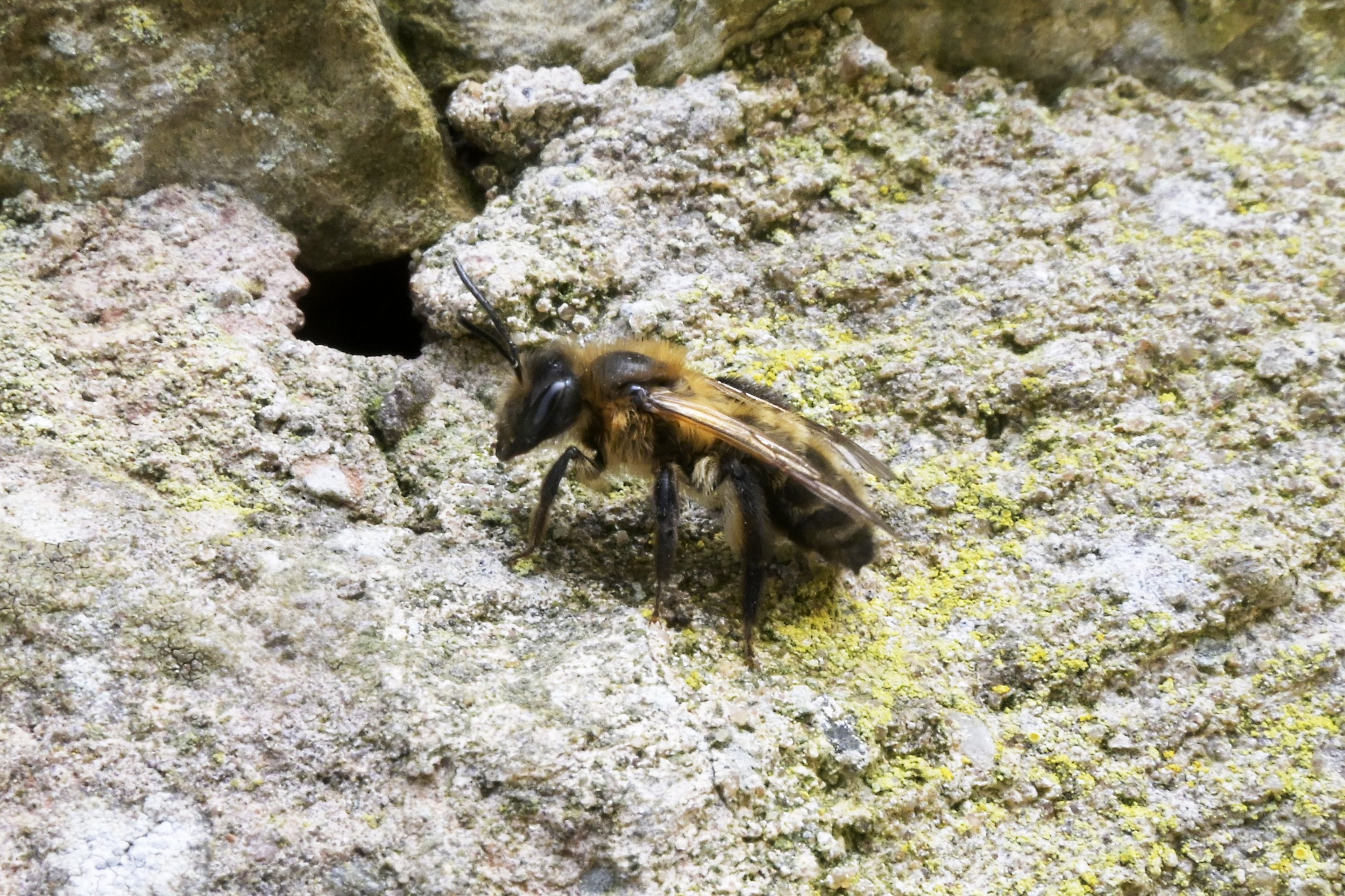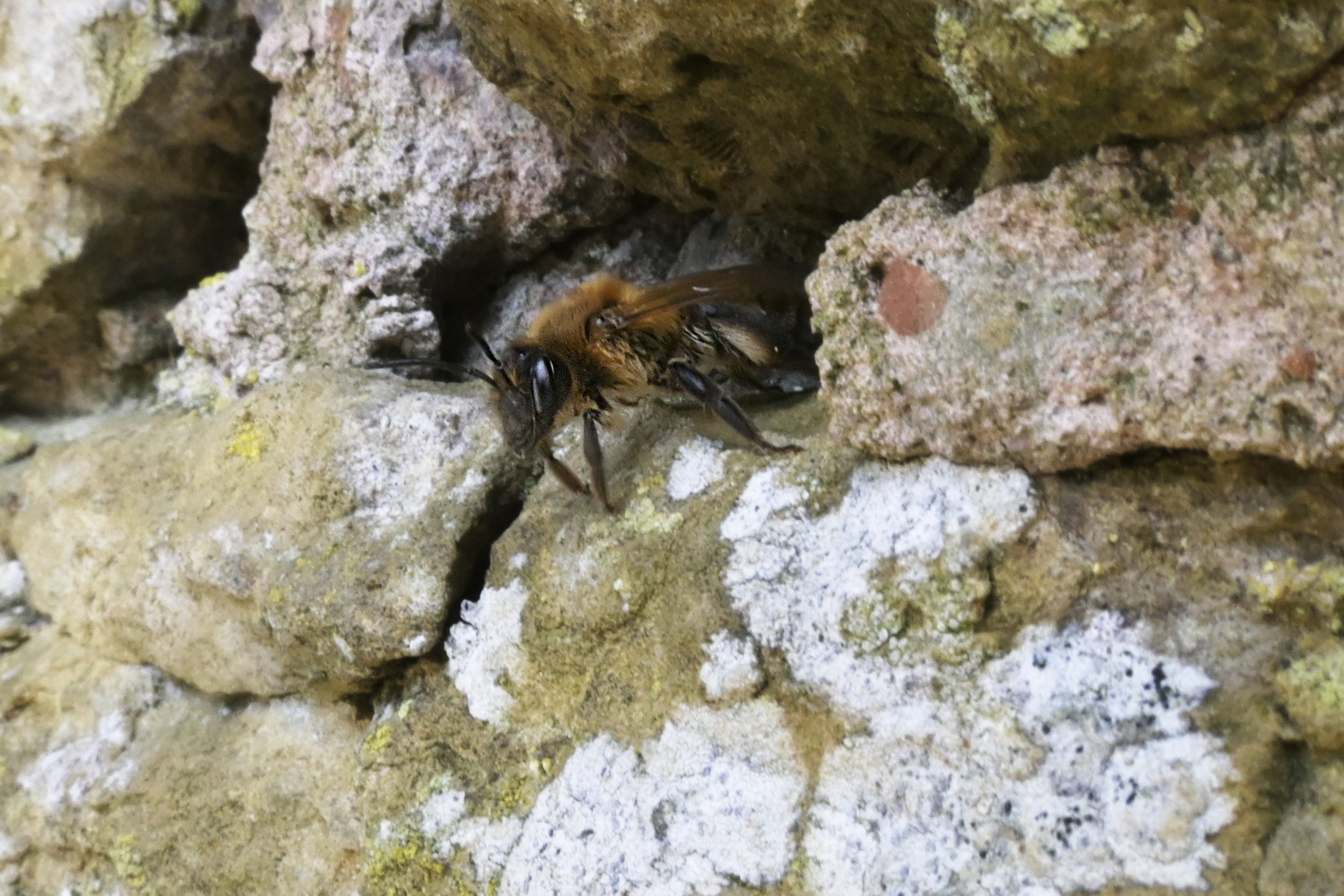BRITISH SOLITARY BEES
I am often sent images and asked to identify different bees and it can be a very difficult thing to do because in the UK alone we have about 270 different species of wild bees, of which 24 are different bumble bees and the rest are solitary bees. Notice the honeybees are not mentioned in that statement because although honeybees are, of course, wild… bar the odd few they live in hives and are kept by beekeepers. So today, as the weather is so awful and I haven’t been able to look at my bees, (I was away at the weekend when the decent weather made an appearance), I thought I would chat to you about the solitary bees.
We had a bit of a flurry in the village last week due to the arrival of some solitary bees in the wall that surrounds the church which also serves our community as a local shop and café - yarpole.org
A little bee had appeared from a hole in the wall and as the weather warmed up so more bees started to emerge. At first glance I thought they were honeybees. They certainly looked like honeybees and they can take up residence in the most unusual places. A hole in the wall with a huge cavity behind would be deemed pretty good to a scout bee! But they weren’t behaving like honeybees. They seemed a bit dopey and the longer I watched them the more I saw that they were appearing from different holes in said wall! So I took a couple of pictures and went home and started Googling solitary bees.
So this weeks blog is a good opportunity to share what I have learned about some of the solitary bees that can be found in our gardens, meadows and woodlands.
Solitary bees, unlike bumble bees and honeybees, don’t live in colonies. They do not serve a queen bee and as their names suggests they live alone. The males, somewhat like the drones in a honeybee colony, don’t help them build their nests, their only job is to mate with the female.
Generally they emerge from their nests in the spring. The males are the first to appear and once they have fed themselves they hover around potential nesting sites waiting to mate with the females. A single mating will fertilise all the females eggs after which the male has no more involvement with the females and he dies pretty soon after!
The female will select a suitable nesting site in which she will build anything from 1 to up to 20 or so individual cells in which to lay her eggs,. She fills these with a form of bee bread. (Bee bread is a mixture of pollen and nectar). She then lays a single egg in each cell. Once she has done that she plays no further part in raising her brood. The eggs hatch into larvae which feed on the bee bread that the female has left for them. The larvae will develop and pupate and emerge the following spring, or later in the year depending on the species, as the next breeding generation.
The males don’t have a sting and the females will only sting if handled roughly or trodden on, therefore they are very safe to have in your garden and around children and pets.
Like the honeybees their numbers are in decline because of the chemicals used in farming, loss of habitat, ie., fewer wild flower meadows due to property development. Fields are becoming larger and so we are losing the hedgerows etc.
Below is a description of just some of the wonderful solitary bees we have in the UK..
Ashy Mining Bee - Found in the earth and patchy lawns or fields for grazing. They collect nectar and pollen from spring flowering trees and shrubs like willow and blackthorn as well dandelions and buttercups. Fascinating fact about the ashy mining bees. When it rains they go back to their nexts and close up the entrance behind them!
Early Mining Bee - So called because they are one of the earliest risers when spring first breaks. They nest in small excavated tunnels underground. Most commonly found in loose, sandy soil close to their favourite fruit trees. They also forage on spring flowering shrubs and trees, including willow, hawthorn and blackthorn and of course fruit trees.
Tawny Mining Bee - They build their nests in flower beds and lawns in gardens and parks and on mown banks and around the edges of farmland and orchards. They nest underground leaving a little volcano-like mound of soil around the mouth of the burrow. They forage on buttercups, dandelions, hawthorn, blackthorn, maple, willows and… fruit trees.
Wool Carder Bee - They make their homes in holes or cavities, including hollow stems and dead wood. Flowering Lamb’s ear provides both forage and nest materials. They do also seek out other plants to collect secretions from in order to build their nests.
Red mason bee - They are commonly found in urban environments, especially gardens and parks. They bury themselves in the cracks of south facing walls, window frames and air bricks. They also nest in holes in bramble stems, dead wood, vertical cliffs and soil banks. But these are the bees you are most likely to see in your bee hotels. They forage on garden plants and spring flowering shrubs and trees, especially apples and pears. They also feed on oilseed rape and re renowned for their efficiency as pollinators. The red mason bee doesn’t collect pollen on her legs, instead they collect the pollen on the hairs on the underside of their abdomen, known as a pollen brush. When the pollen brush is full their abdomens can look very bright depending on the pollen they have been collecting.
Hairy-footed Flower bee - How can you not love a bee with a name like that? The males of this species are far more colourful than the females who are black all over and don’t have hairy feet! They nest in shallow hollows in soft mortar, vertical soil profiles and, as above, soft cliff faces. Occasionally they can be found in the ground in compact clay soils. This little bee forages on early spring flowers such as lungworts, primroses, comfrey and dead nettles.
Leaf-cutter bee - If you’ve ever noticed little crescent shaped segments cut away from your rose leaves and lilac shrubs? Will it could be made by the leafcutter bee. They don’t actually cause any more harm to your plants than the appearance of them. These little bees live in hollow plant stalks and cavities in wood and fill them with segments of leaf which are overlapped and form a series of individual cylindrical shape cells in which they lay their eggs. They eat pollen and nectar from flowers and like the red mason bee, they collect the pollen on the underside of their abdomens.
Scissor bee - These are Britains smallest bee and they become active in the summer, foraging on wild flowers. They nest in woodworm holes in dead wood and collect pollen from bellflowers. The males sleep inside the flowers!
Orange-tailed mining bee - They live underground on grassy slopes and mostly forage on blossoming shrubs, dandelions and umbellifers.
Long-horned bee - This is one of the UK’s largest solitary bees and although they are solitary they tend to live in large gatherings in flowery meadows, on soft rock cliffs quarries and woodland clearings. The males are very distinctive due to their long antennae. They are in decline because they need large areas of flowering habitat. Over grazing, poor management of grassland, coastal development and stabilisation of soft rock cliffs are all contribute to their decline. These bees emerge in May and forage legumes such as clovers, kidney vetch, meadow vetchling and everlasting-peas.
Common mourning bee - This little bee is known as the ‘cuckoo bee’ of the Hairy-footed flower bee. Therefore their habitat is wherever there are nesting aggregations of the Hairy-footed flower bee. The female lays her eggs in their nests and the larvae eat the food stores gathered for the Flowers-bee’s own young.
Yellow-faced bee - Like the long-horned bee - these too are in decline which is largely due to invasive ants. They’re often mistaken for wasps because of their yellow faces. They do not gather pollen on their backs or legs but have to swallow it and regurgitate it when they get back to their nests. These bees emerge in the late summer. They live in cavities in walls and hollow stems and line their nests with abdominal secretions. They like swamp milkweed and common boneset among other native plants.
I will leave it there! I hope you’ve enjoyed this little dip into the world of the solitary bees.
Having done my research for this blog I think it is safe to say that the bees in our church wall are leaf-cutter bees! They aren’t aggressive… nonetheless… I’ve advised people to give that section of the church wall a wide berth!
I’ve been on a massive learning curve and hopefully have chosen the most common of our 200 + solitary bees to show you. Perhaps now I can identify images sent to me without having to first Google them! Also, when you’re in your gardens you can see how many different sorts of solitary bees you can spot. And…don’t forget you can always help our solitary bees by providing them with little bee houses in your garden or on your balcony, if you live in a flat. You can buy them almost every where now and they are very easy to make. There are endless video’s on you tube or just your creative skills and imagination!
As I type these last few words the rain continues to fall. I know people say it’s April Showers but we’ve been having them here in Herefordshire since January! I think we all deserve a break.
QUOTE OF THE WEEK
“ALONE WE CAN DO SO LITTLE. TOGETHER WE CAN DO SO MUCH”
Educational Triangle available from allcoopedup.co.uk/education-triangle-a-k-a-crittacabin.html

